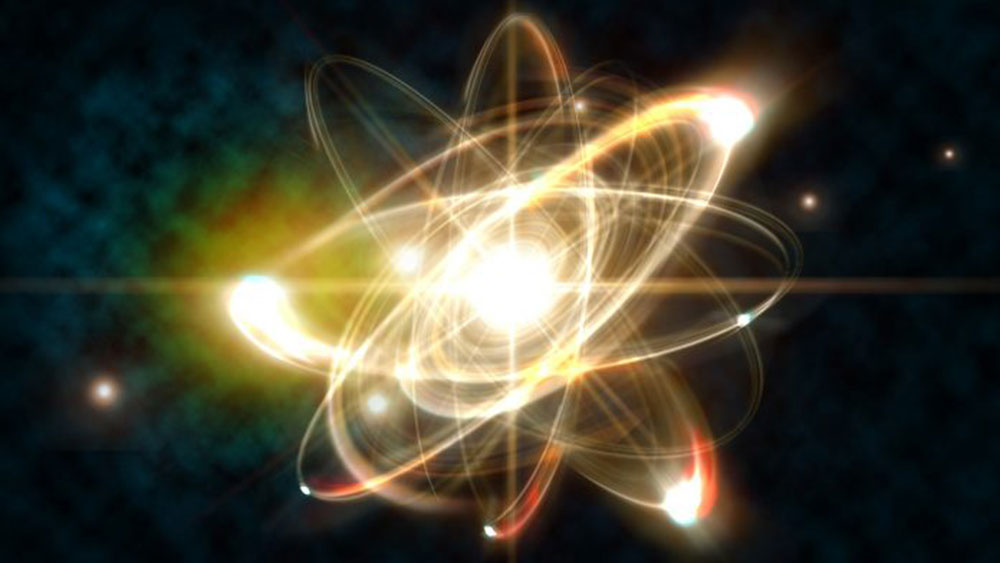The Electron-Ion Collider: A Precision Tool for Studying the 'Glue' that Binds Visible Matter
Professor Abhay Deshpande, of Stony Brook University and Brookhaven National Laboratory, and Dr Zein-Eddine Meziani, of Argonne National Laboratory, outline the potential of the planned Electron-Ion Collider and the many questions about the Universe that it hopes to answer
March 4, 2022
The following article was written by Abhay Deshpande, director of science for the Electron Ion Collider at Brookhaven National Laboratory and a professor at Stony Brook University, along with Zein-Eddine Meziani of Argonne National Laboratory, for the Innovation News Network . The story will appear in an upcoming print edition of The Innovation Platform, a journal that covers advances in scientific discovery and the important supporting frameworks that drive science forward.
The Electron-Ion Collider (EIC), planned to be built at the U.S. Department of Energy’s (DOE) Brookhaven National Laboratory (BNL), in partnership with Thomas Jefferson National Accelerator Facility (Jefferson Lab), will be the most advanced tool for studying some of the deepest unexplored recesses of the atom. It will peer into protons and neutrons, the building blocks that make up atomic nuclei, providing unprecedented insight into how those particles’ internal building blocks—and the gluelike force that holds them together – build up the structure of nearly all visible matter in the Universe.
Electron-Ion Collider Science: Origin of mass
We know that a proton is made up of quarks and a sea of gluons (see box). Those gluons also keep producing quarks and anti-quark pairs (called sea-quarks). So, the internal microcosm of a proton is abundantly full. One could assume that this abundance of particles would explain where protons get their mass, but quarks are nearly massless, and gluons have no mass. If we add up the masses of the quarks that make up the proton, they account for only about 1% of the proton’s total mass.
Where is the remaining 99%? Astonishingly, it appears to come from the interaction energy among the proton’s inner building blocks. In fact, it looks like the nucleons, nuclei and, by extension, all the planets and galaxies of the visible Universe get their mass through interactions of massless gluons and almost massless quarks. How does this happen? The Electron-Ion Collider will resolve this profound and longstanding mystery.
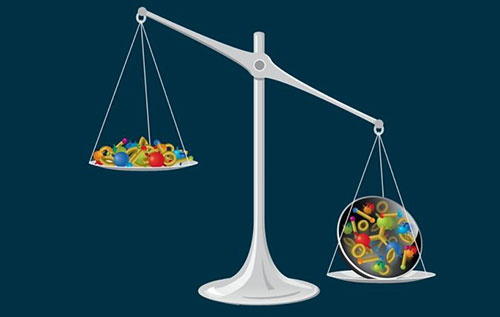 enlarge
enlarge
Fig 1: The sum of the mass of the particles that make up a proton – quarks (large colored spheres), gluons (yellow squiggles), and quark-antiquark pairs (smaller spheres) – comes to 1.8 x 10-26 g, while the proton containing those particles and their interactions weighs almost 100 times more. EIC may reveal exactly how the quark-gluon interactions generate the bulk of a proton's mass
Since the 1960s, physicists have known that protons and neutrons, referred to collectively as nucleons, are made up of fundamental particles called quarks, bound together by a force resulting from the exchange of gluons. We call this the ‘strong force’. The strong force depends on the existence of a different type of charge, called the ‘color charge’. Unlike ‘electric charge’, which comes in two varieties (positive and negative), the strong force seems to have three types called ‘colors’ (red, blue, and green).
Another important difference is that, unlike the photons that mediate the electromagnetic force, the gluons that mediate the strong force can and do interact with one another. That is one of the characteristics that makes the strong force so strong. In fact, it makes it impossible to find a free quark in nature. Instead, quarks are always confined within composite particles such as protons. Within the protons, however, the quarks are essentially free to move around.
Despite more than six decades of exploration, our knowledge and understanding of this apparent discrepancy between quark confinement and asymptotic freedom within protons, as well as the gluons’ role in strong force interactions, are surprisingly insufficient compared with our understanding of electromagnetism—the force at the heart of today’s electronic technologies. Can we do better? Yes, but for that we need to pin down the gluon and understand its gluelike behaviour much more precisely. For that, we need the EIC. What we learn may unlock the secrets of the strongest force in nature and potentially new ways to apply that knowledge.
Electron-Ion Collider Science: Origin of spin
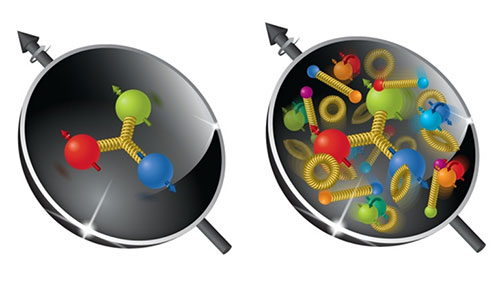 enlarge
enlarge
Fig 2: Protons and neutrons are made up of three valence quarks (shown as large colored spheres with arrows), a sea of gluons (yellow wiggles), and sea quarks (pairs of smaller colored quarks and antiquarks in the right figure). EIC will explore how these quark and gluon spins and their possible orbital motion generate the total spin of the proton
Quarks and gluons also have a property called spin – a form of intrinsic angular momentum. You can think of spin as similar to the rotation of Earth around its own axis, resulting in days and nights. Being part of the proton, which also has a definite ‘spin’, the quarks and gluons are naturally expected to contribute to the proton’s spin. However, experiments performed so far indicate that quark and gluon spins can explain only about 40-50% of the total spin of the proton.
Scientists think that the remaining spin of the proton must come from the motion of the quarks and gluons inside the proton being aligned with the proton’s orbital angular momentum – which, in the case of Earth, would be the planet’s motion around the Sun. There is ample evidence of such transverse motion of quarks and gluons inside the proton, but only the EIC will be able to measure if that motion is consistent with the angular momentum. If true, a beautifully consistent picture may emerge, showing that the orbital motion explaining the spin of the nucleons also results in the energy of quarks and gluons, simultaneously explaining the mass of the proton.
EIC Science: Gluon saturation
Measurements from past experiments have shown that gluon number density inside nuclei increases at high energy. The theory that explains quark-gluon interactions can explain this increase. However, at extremely high energy, beyond what has been experimentally explored, certain fundamental rules and arguments of that theory and fundamental physics suggest that there is a cap on how high gluon density can rise.
In such a regime, a novel state of saturated gluonic matter, called the Color Glass Condensate (CGC), is expected to be formed. Theoretical studies of CGC suggest that it should have some remarkably intriguing properties, including energy density as high or higher than that in the core of neutron stars, the densest objects in our Universe. Does such an exotic form of gluonic matter really exist? If so, what are its properties and how can we study them systematically? If CGC does not exist, then what unknown mechanism in physics puts a cap on the number of gluons at high energy? The Electron-Ion Collider will explore this mystery.
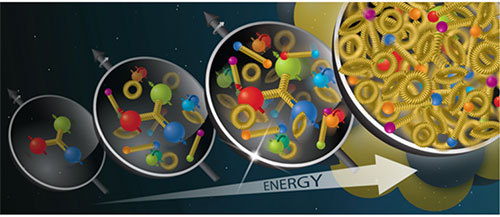 enlarge
enlarge
Fig 3: The number of gluons in the proton increases with energy. Theory predicts it must saturate to form a novel gluonic form of matter called the Color Glass Condensate. Discovery and detailed study of CGC is one of the primary goals of the EIC
The EIC moves forward
Recognising the importance of understanding the origin of mass and spin and the potential for discovering and studying a saturated gluonic state in nucleons and nuclei, an international community of physicists outlined the parameters of a machine that could embark on an exploration of this new frontier in nuclear physics.
The consensus called for construction of a high-intensity, high-energy electron-ion collider with controlled spin orientation of particles in the colliding beams. A 2018 report from the US National Academy of Sciences, Engineering and Medicine (NAS) concluded that the “EIC science is compelling, fundamental and timely.” In January 2020, the U.S. Department of Energy (DOE) announced that the facility would be built at Brookhaven National Laboratory in New York. A recent review set the cost range for the EIC to be $1.7-2.8bn from the DOE Office of Science, with anticipated contribution of $100m from New York State.
A team of physicists, technicians, engineers, and other professionals from Brookhaven Lab and Jefferson Lab, as well as other collaborating partners from around the world, is now working to make the EIC a reality. The team hopes to start construction in 2024, aiming for a collider operation date within the 2030s.
The EIC will have the below main features:
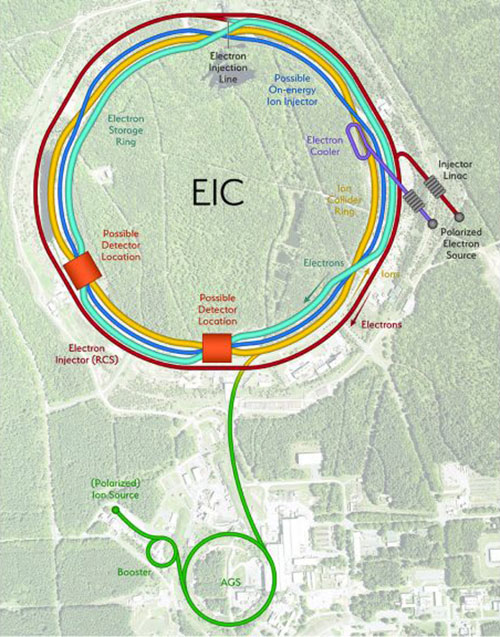 enlarge
enlarge
Fig 4: The EIC will use the existing tunnel of the Relativistic Heavy Ion Collider (RHIC), currently operating as a DOE Office of Science user facility for nuclear physics research at Brookhaven Lab, along with one of its existing ion accelerator rings (shown in yellow). A new electron beam facility (red and cyan) will be built to inject, accelerate, store, and collide electrons with ions — atomic nuclei stripped of their electrons — at two possible detector locations. The ion beams will be prepared at the ion source and accelerated through an existing chain of accelerators (green), including the booster and the Alternating Gradient Synchrotron (AGS)
High luminosity: The EIC will produce particle collisions at a rate of 1 × 1034 per square centimetre per second. Lots of collisions (also referred to as high luminosity) means lots of data.
High polarization: Both the electrons and some ion beams will be polarized, making the EIC the only facility in the world with this capability. This means the particles’ spins can be aligned in a particular way. EIC physicists will collide polarized particles to study how the spins and orbital motion of their internal building blocks contribute to their overall spin.
High energy: The EIC will produce collisions at variable center-of-mass energies, from 20 billion to 140 billion electron volts (GeV). At the scale of ordinary things, that is less energy than two mosquitoes colliding. But, at the scale of an electron colliding with a proton, it is enough to produce high-resolution snapshots of the proton’s internal components.
Varied ion species: The ion sources for the EIC, already in use at the Relativistic Heavy Ion Collider (RHIC) and the adjacent NASA Space Radiation Laboratory, can provide ions of almost any element on the periodic table. Light ion beams (protons, deuterons, and helium-3) will emerge polarized from their source. EIC scientists will use a wide range of beams, from protons to heavy ions, to explore how ion size and other features of nuclei affect properties and interactions of quarks and gluons.
Designing EIC detectors
Scientists around the world are also working to design detector systems that will make the most of the EIC’s technical capabilities. The EIC Users Group (EICUG) was formally established in 2016 and has been actively working with the Brookhaven Lab and Jefferson Lab management teams and with the DOE on plans. Starting with about 700 scientists, the group has now grown to more than 1,300 participants from over 250 institutions and 33 countries. By the time the EIC is ready for operations, some 2,000 scientists are expected to conduct experiments.
The EIC Project Management team issued a call for detector collaboration proposals in February 2021. This call formally launched the process of refining detector designs and the formation of experimental collaborations. Three teams submitted detailed plans, now under review by an external committee appointed by the Brookhaven Lab and Jefferson Lab management teams.
Ideally, EIC scientists would like to build two complementary detectors so they can collect different kinds of data and/or cross-check one another’s findings. The Brookhaven collider complex has two interaction regions for such large-scale EIC detectors. The EIC project within the DOE Office of Science includes funding for the accelerators, one interaction region, and one detector.
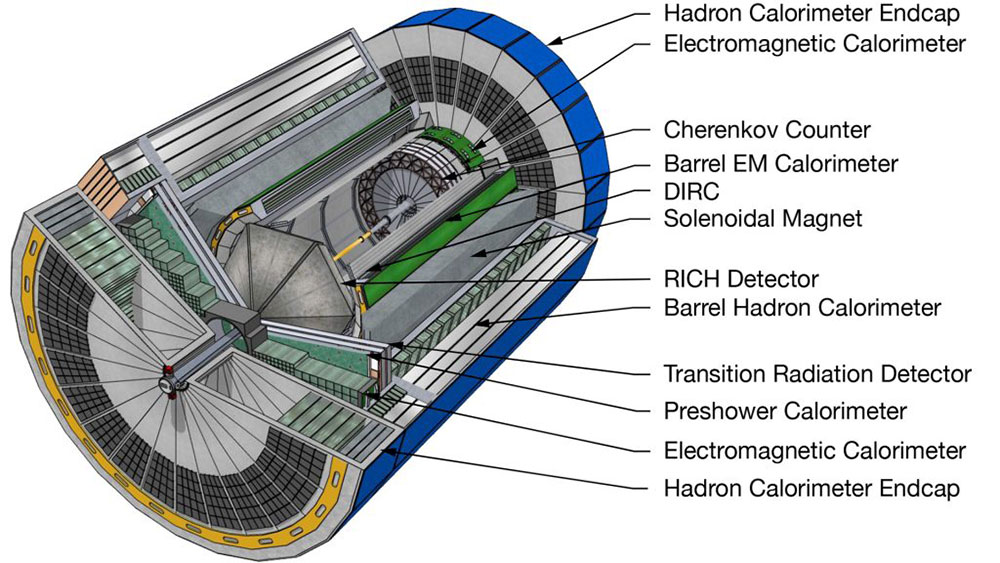 enlarge
enlarge
Fig. 5: An ideal EIC detector, as envisioned in an EIC User Group report, includes subdetector systems for tracking and identifying various types of particles and measuring characteristics such as their energy and momentum
As part of the Electron-Ion Collider team’s collaboration-building strategy, the project team and user group are working to attract additional funding sources, including international and non-DOE funds. Some of this additional non-DOE-sourced funding could potentially be used to build a complementary detector system in the second interaction region to maximise the scientific output of the EIC complex. The EIC project stands ready to explore all such possibilities and would welcome any such initiative for collaboration from around the world.
Societal benefits
The EIC will be one of the world’s most complex accelerator projects ever designed and operated. The versatility and flexibility in its operation make the EIC a challenging but exciting machine to work on. Physicists and engineers involved in the project will be developing many state-of-the-art (or beyond) accelerator technologies to make this machine a reality over the next several years. Such a challenging endeavour will attract the world’s most talented and ambitious accelerator scientists. Collaborations are being initiated with leading national and international accelerator laboratories to contribute and participate in the EIC design. Similar international cooperation is expected to emerge once detector construction begins and when the EIC becomes operational.
Such a concentrated effort to design and develop new technologies will likely spark innovations that have impacts well beyond the field of nuclear physics. Cancer therapy is one example. The particle-beam-related improvements for the EIC could lead to improved delivery and quality of particle beams used to treat cancer with reduced cost and improved efficiency and efficacy.
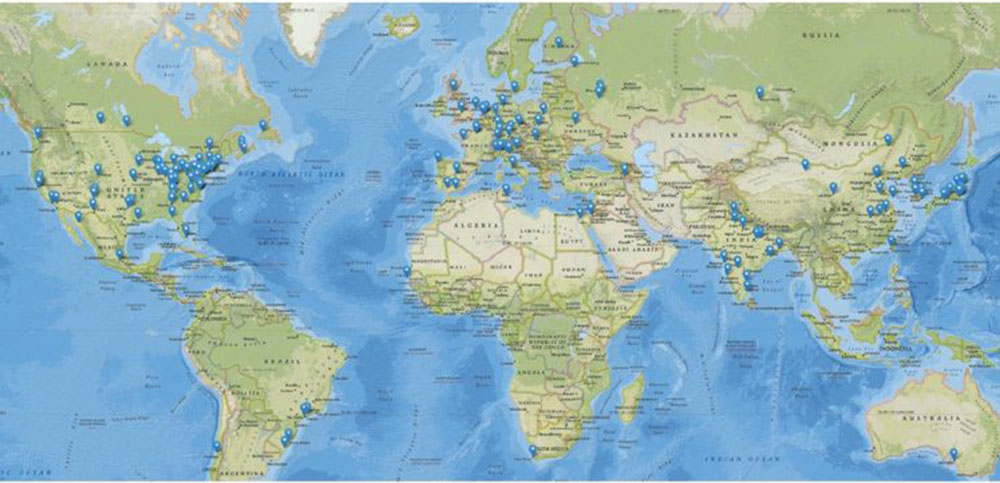 enlarge
enlarge
Fig. 6: Map of institutions that form the EIC Users Group. Current membership stands at over 1,300 scientists from more than 250 institutions and 33 countries
Another potential impact could be improvements to accelerators used in industry – for example, to test computer chips, study new materials for batteries and solar cells, and develop alternative and clean energy technologies. These improvements would also benefit the biomedical industry, where accelerators are used to study different kinds of proteins, including for drug and vaccine development, and for inspecting and keeping our food supply safe.
The research and development (R&D) anticipated for Electron-Ion Collider detector components will also push the evolution of technologies and bring in new ideas that could be directly exported for use in security operations, for example to identify illicit drugs in closed cargo containers or to identify other national security (sensitive) materials.
In addition, the EIC’s need for highly efficient data collection, storage, and analysis will spark advances in computing that extend to other fields, including finance, climate modelling, and other data-intensive challenges.
Finally, and perhaps most importantly, by attracting the best science, technology, engineering, and mathematics (STEM) workforce from around the world to build and run the EIC, we will be building up a tech-savvy workforce for tomorrow while also building bridges that connect nations of the world.
Students and researchers from different nationalities and cultures will come together to work on some of the most challenging conceptual and technical problems in nuclear and particle science and on accelerator and detector technologies—while also learning about one another. In the long run, through those collaborations, they could become ambassadors of peace and friendship among countries and cultures across the world. The tools, technologies, and connections they develop will benefit mankind for many decades to come.
2022-19454 | INT/EXT | Newsroom




